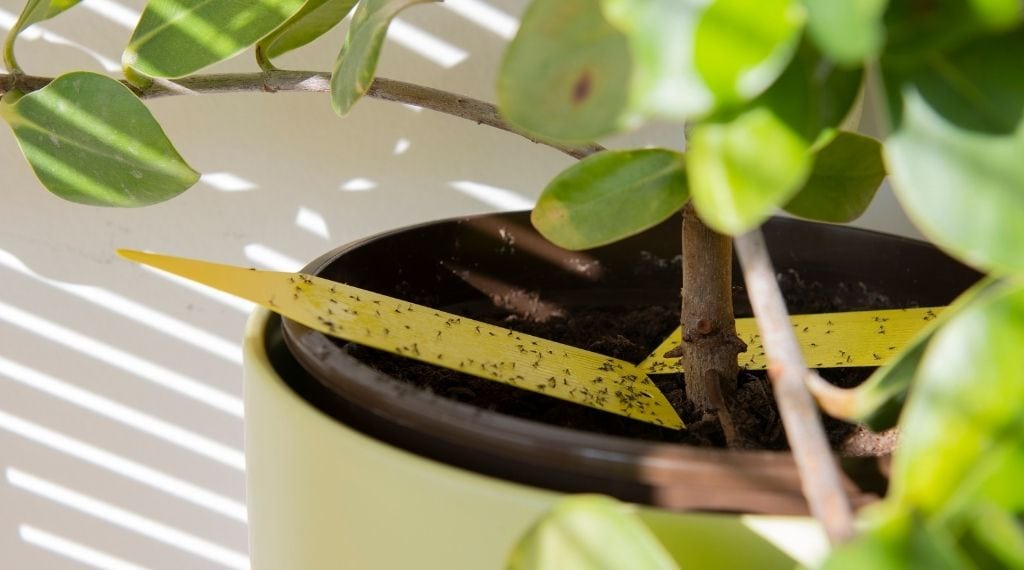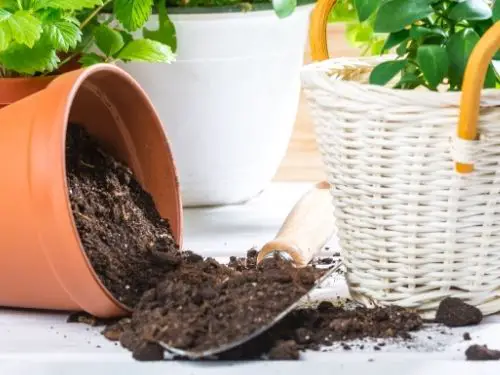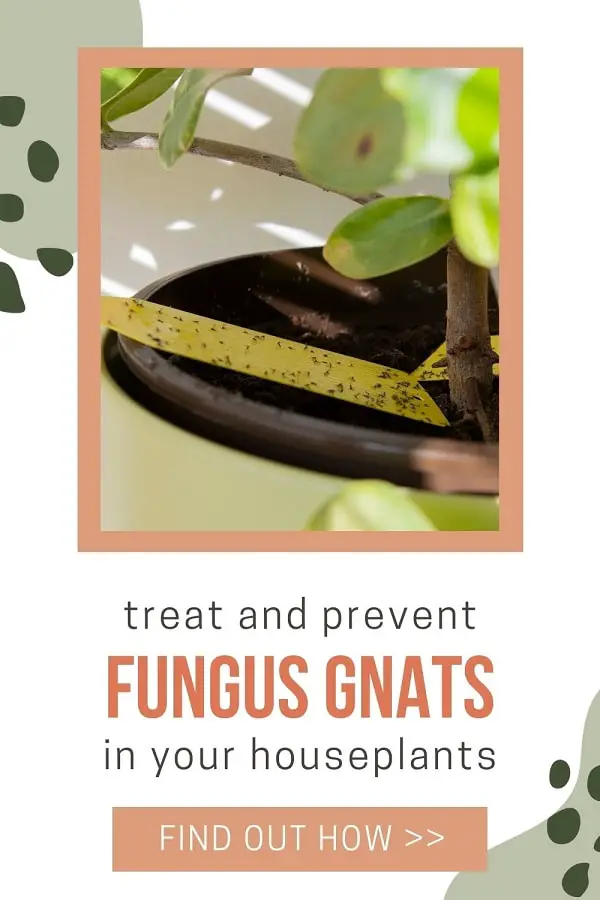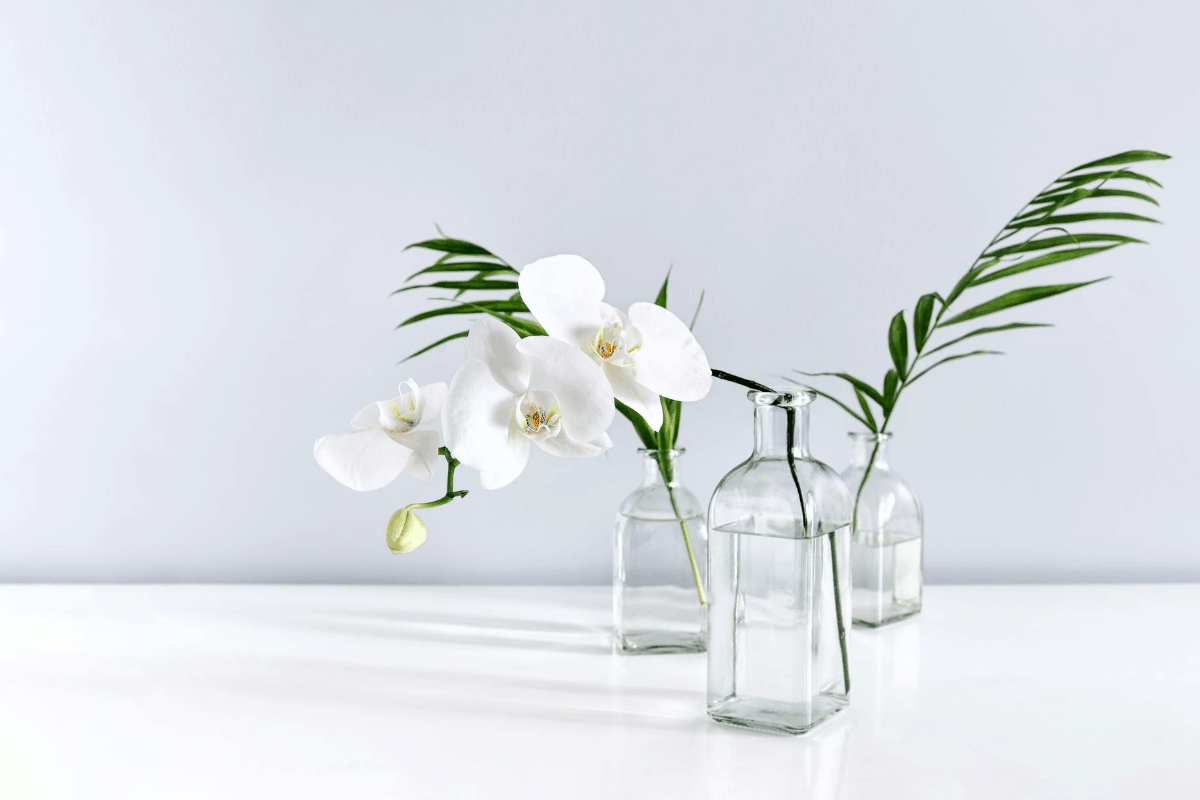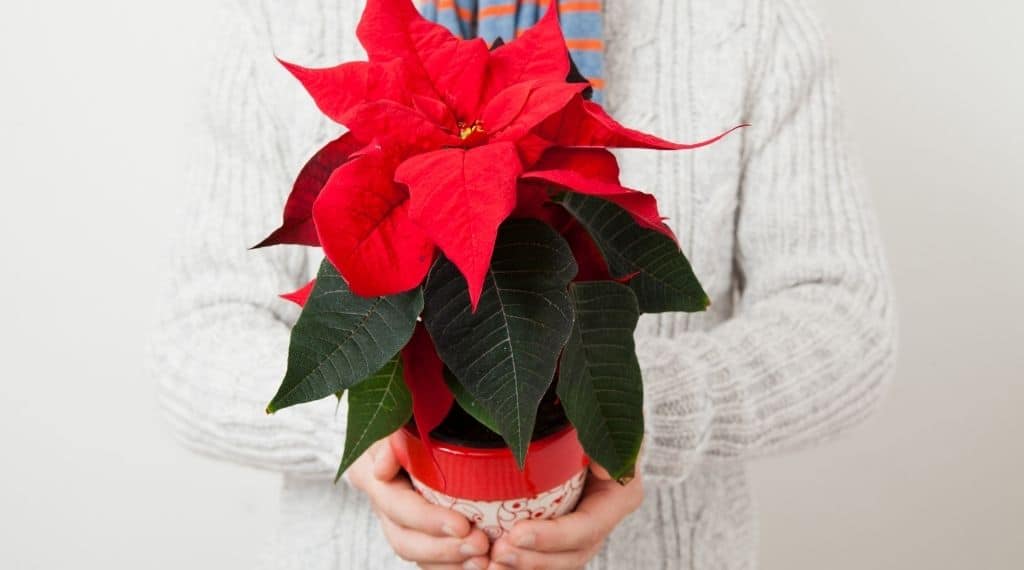Last Updated on October 5, 2021 by Plantiful Interiors
How to Get Rid of Fungus Gnats in Houseplants
Fungus gnats are pests that infest houseplants, especially in climates that have a lot of moisture in the air. Fungus gnats can cause damage to the plants inside your house. No one wants a bug infestation in their home. So how do you get rid of a fungus gnat infestation once you have one?
Fungus gnats are loathsome and annoying and to people, and they are damaging to indoor plants. Luckily, there are several ways to get rid of them. Methods involve using chemicals or natural remedies. Read on to learn how to get rid of fungus gnats in houseplants, as well as how to prevent infestations.
This site features affiliate content. As an affiliate partner of various brands, we earn commissions on qualifying purchases, at no extra cost to you. Please read our disclaimer for more information.
Determine If You Have Fungus Gnats
The first step in knowing that you have a problem is identifying the signs of a fungus gnat infestation. Some signs are more obvious than others.
Signs that you have a fungus gnat infestation:
- Small flies near your houseplants
- Larvae inside soil
- Houseplant appearing sick
If you have a bunch of small flies roving around your houseplants or house, you clearly have a fungus gnat infestation. You need to check all of your plants’ soil to see if you find any larvae. They love moisture and will make their homes inside the soil.
If you notice your plant has started appearing sick, it could be a sign that it is infested with fungus gnats. A sick plant could show symptoms in the form of leaves dying or turning yellow. The plant might also start to wilt.
Use Insecticides to Get Rid of Fungus Gnats
Fungus gnats will not kill your plants, but they can cause severe damage to your plants if there are enough of them. Regardless, fungus gnats are pests in our house and can be annoying to deal with. If you want your fungus gnats gone quickly, chemical pesticides will do the job.
There are a few different ways to get rid of fungus gnats. The first set of options are over-the-counter items you can buy to get rid of your fungus gnat problem. Keep in mind that killing the larvae is slightly more difficult than killing adult fungus gnats.
For Adult Fungus Gnats
For adults, you can use a basic flying insect spray to kill them.
This will not be your only step since you still have to deal with the larvae, but it is effective against adults.
For Fungus Gnat Larvae
Fungus gnat larvae live in the soil of your houseplants, which means you will need something that can penetrate the soil to get rid of the larvae before they hatch.
There are soil drenches and sprays that are effective against fungus gnat larvae. The spray also kills adults.
There are different types of pesticides that can handle getting rid of the fungus gnats plaguing your plants and home. Some insecticides poison the gnats, but these can be unsafe for people to handle, especially if your houseplants are in the kitchen.
There are organic options that kill the fungus gnats on a biological level without endangering you or your family.
Use a Hydrogen Peroxide Mix Applied to Soil
Using a mixture of hydrogen peroxide and water can eliminate fungus gnat larvae. This is a safe method that eliminates the larvae without causing damage to you or your plant.
- Use a three-percent solution of hydrogen peroxide.
- Use one part hydrogen peroxide per four parts water.
- Once the solution is made, apply the peroxide solution to the infested houseplant’s soil.
- Avoid splashing the peroxide solution onto the leaves of the houseplant.
Capture Adult Fungus Gnats With Yellow Sticky Traps
The yellow sticky trap method will work on adult fungus gnats. The sticky trap method takes advantage of the fact that adult fungus gnats love the color yellow. When the adult fungus gnats land on the trap, they get stuck and are unable to fly away. They eventually starve.
This is an effective method that does not use harmful chemicals found in insecticide. Make sure you set up the sticky traps near the houseplants that you want to protect from fungus gnats. This will make it much easier to trap as many gnats as possible.
It is recommended that you do not place the traps in a heavy traffic area due to the trap’s sticky nature. They can get stuck to children, shoes, or pets.
Use Natural Remedies to Treat Fungus Gnats
You do not need harmful chemicals or anything manufactured to get rid of your fungus gnat problem. There are a few natural remedies that you can use to take control of your infestation and to prevent the fungus gnats from coming back.
Change Your Soil
Since fungus gnat larvae live in soil, one effective way to get rid of them is to change your soil out for brand new soil. Discard the old soil, and make sure you check for larvae. Repot the plant with the new soil, and your plant should be free of all the fungus gnat larvae.
This is an effective way to ensure that you get rid of all the larvae without requiring any pesticide or other chemical products. However, if there are still adult fungus gnats in your house, they can lay more eggs in the new oil. Ensure you kill all adult gnats first, and take the proper steps to make your climate unwelcoming to fungus gnats.
Dry Out Your Soil to Dry Out the Larvae
Fungus gnat larvae require moisture to grow and survive. If you take away the moisture from the soil in which they live, the larvae will dry up as well. Without moisture, the larvae will die. To get rid of the larvae using this method, follow the steps below:
- You will need to let the soil dry out completely.
- Once the soil is dried out and the fungus gnat larvae are dead, you need to ensure that the soil is getting the proper amount of moisture.
- Since fungus gnat larvae love moist soil, do not overwater your plants.
- It is vital that you keep checking on the soil to ensure there is no further infestation.
You May Also Enjoy: What is the Best Potting Soil for Houseplants?
Make A Liquid Trap
You can make your own organic gnat trap. This method works for all kinds of adult gnats, not just the fungus gnats that infest your houseplants. This apple cider vinegar trap is highly effective against adult fungus gnats.
Put a small amount of apple cider vinegar in a bowl with a few drops of Dawn or other liquid dish soap. The apple cider vinegar attracts the gnats to the bowl. Once the gnats touch down in the bowl, they cannot get back out due to the dish soap. They get stuck and eventually drown in the solution.
Prevent Fungus Gnat Infestations Before They Start
The best thing you can do is to be proactive when it comes to taking care of your houseplants. You can use several techniques to ensure that you do not get a fungus gnat infestation in the first place.
Keep Fungus Gnats Out of Your Houseplants
It might sound repetitive but controlling the amount of moisture in your plants is essential. Fungus gnats are attracted to warm, moist soil environments. Prevent your soil from getting too moist, and fungus gnats will not infest them.
- Put sand or gravel on top of your soil.
- Change how you water your plants.
A good way to prevent fungus gnat larvae from getting in your soil is to put one to two inches of gravel or sand at the top of the soil. This makes your plant unattractive to the fungus gnats.
By watering your plants from the bottom up, you ensure that the houseplant gets enough moisture without making the top of the soil wet. Moist soil leads to more fungus gnats.

